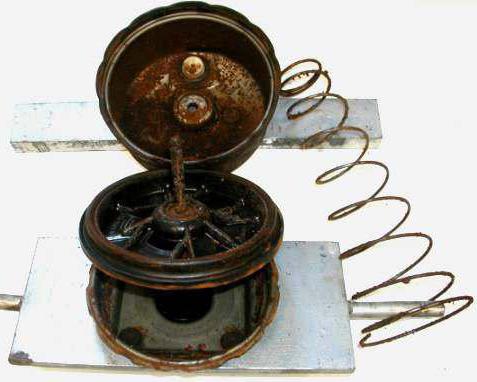Vacuum brake booster: how to check? Car maintenance
Most modern carsare equipped with hydraulic brake system. It is supplemented by a vacuum amplifier. This mechanism increases the force imposed by the driver on the pedal several times. In other words, it is much easier to brake with a vacuum cleaner. However, like any other mechanism, the amplifier can malfunction. In today's article, we will look at how the vacuum brake booster is arranged, how to test it and what its operating principle is.
Device
The design of this element assumes the following details:
- Diaphragms.
- Atmospheric channel.
- Pusher.
- Stock.
- The vacuum channel.
- Piston and return spring.
How does it work?
The principle of operation is based on the difference in pressure. The amplifier body includes two circuits separated by a membrane. One part of the circuit is connected to the hose (where the discharge is from). The other end is connected to the follow-up valve. It controls the change of the discharge and adjusts the parameters.

How to check? Method number 1
There are several methods for diagnosing thiselement. All of them will be considered in our article. So, how to check the valve of the vacuum brake amplifier by yourself? You can diagnose the device without removing it from the installation place.

Method No. 2
This method of verification is as follows. You need to start the engine and press the pedal. Then stop the engine. In this case, the pedal is held in the floor, not releasing it. After 20-30 seconds, release it. The mechanism must return to its original position, because excessive pressure was generated in the circuit. If the pedal "failed", this indicates a leak in the vacuum chamber.

Repair of the vacuum brake booster: what goes wrong?
Often with breakage of the "vacuum cleaner", the diaphragm breaks down. In the presence of ruptures from the outside of the housing, air enters the vacuum cavity. Because of this, the system does not provide the required discharge.

Dismantling
Replace failed components in placeit will turn out. It is necessary to remove the vacuum brake booster. VAZ classic models (including the "Samara") is equipped with this element near the engine board. So, open the hood, turn off the amplifier from the main brake cylinder. The important thing is that the tubes stay in place. If they are removed, the system will be airborne.

Disassembly and repair
Next, we will need a vise. Clamp the amplifier in a vice and bend the grooves of fixing the two "halves". This is done with a minus screwdriver. On the last rivet, try to hold the outer part of the case. Since there is a spring inside it, when the case is analyzed, it can shoot. Further we remove from fastenings two rubber covers and a plastic casing with a pusher.

- Diaphragm.
- Cuffs.
- 2 cases.
- Anthers.
- Valve.
Having installed new parts, we collect it backthe vacuum amplifier of brakes. How to test it, we already know. When assembling, the diaphragm must immediately be fastened to the plastic casing. The spring can be installed by either side. However, when assembling the body, you need to make efforts to get it on the studs.
Assemble in the reverse order. Before starting, make a visual inspection. All hoses and clamps must be snug and securely fastened. If the motor is moving, then the air is sucked. Perhaps one of the hoses has been damaged.
So, we found out what a vacuum brake booster is, how to test it and repair it yourself.
</ p>



